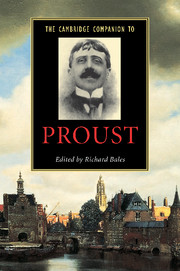Book contents
- Frontmatter
- Introduction
- 1 From Belle Epoque to First World War
- 2 The vast structure of recollection
- 3 Ruskin and the cathedral of lost souls
- 4 The birth and development of A la recherche du temps perdu
- 5 Lost and found: the structure of Proust’s novel
- 6 Proust’s Narrator
- 7 The unconscious
- 8 The texture of Proust’s novel
- 9 Proust’s human comedy
- 10 Proust and social spaces
- 11 Love, sexuality and friendship
- 12 Proust and the fine arts
- 13 Proust and posterity
- Postlude
- Select bibliography
- Index
12 - Proust and the fine arts
Published online by Cambridge University Press: 28 May 2006
- Frontmatter
- Introduction
- 1 From Belle Epoque to First World War
- 2 The vast structure of recollection
- 3 Ruskin and the cathedral of lost souls
- 4 The birth and development of A la recherche du temps perdu
- 5 Lost and found: the structure of Proust’s novel
- 6 Proust’s Narrator
- 7 The unconscious
- 8 The texture of Proust’s novel
- 9 Proust’s human comedy
- 10 Proust and social spaces
- 11 Love, sexuality and friendship
- 12 Proust and the fine arts
- 13 Proust and posterity
- Postlude
- Select bibliography
- Index
Summary
Few authors foreground the arts quite so comprehensively as Proust; certainly, none made them so central to their own literary production. Proust's whole life was saturated with love of the arts, and so too was to be his great novel: probably no other work of literature celebrates the arts as totally as his, or is so convincing in this pursuit. If one could point to, say, Joyce or Thomas Mann as examples of writers who display a keen awareness of the literary possibilities of incorporating the arts into the fabric of their own work, even their efforts seem small when compared to Proust's.
We are fortunate in possessing a clear picture of Proust’s artistic tastes in his youth, and as he grew up. Two general questionnaires which he filled in have survived (CSB, pp.335–7), and the entries for the arts make fascinating reading: if, at the age of about fourteen, there is a predictable juvenility about some of his choices (George Sand, the historian Augustin Thierry, Musset, Meissonnier, Mozart, Gounod), there are already signs of the maturity which was to be expressed, fully-fledged, in the questionnaire completed at the age of 21. Here, the list acquires more substance: Anatole France, Pierre Loti, Baudelaire, Vigny, Beethoven, Wagner, Schumann, Leonardo da Vinci, Rembrandt. And, as if to underscore the import of his choices, at the top of the questionnaire Proust has written ‘Marcel Proust par lui-même’ [‘Marcel Proust on himself’].
- Type
- Chapter
- Information
- The Cambridge Companion to Proust , pp. 183 - 199Publisher: Cambridge University PressPrint publication year: 2001
- 11
- Cited by



